How to make a solar collector for heating with your own hands: a step-by-step guide
The rise in cost of traditional energy sources encourages private home owners to look for alternative options for heating their homes and heating water.Agree, the financial component of the issue will play an important role when choosing a heating system.
One of the most promising methods of energy supply is the conversion of solar radiation. For this purpose, solar systems are used. Understanding the principle of their design and the mechanism of operation, making a solar collector for heating with your own hands will not be difficult.
We will tell you about the design features of solar systems, offer a simple assembly diagram and describe the materials that can be used. The stages of work are accompanied by visual photographs, the material is supplemented by videos about the creation and commissioning of a home-made collector.
The content of the article:
Operating principle and design features
Modern solar systems are one of the types of alternative sources receiving heat. They are used as auxiliary heating equipment that converts solar radiation into energy useful to home owners.
They are able to fully provide hot water supply and heating during the cold season only in the southern regions. And only if they occupy a sufficiently large area and are installed in open areas not shaded by trees.
Despite the large number of varieties, their operating principle is the same. Any solar system It is a circuit with a sequential arrangement of devices that supply thermal energy and transmit it to the consumer.
The main working elements are solar panels based on photocells or solar collectors. Technology solar generator assembly on photographic plates is somewhat more complicated than on a tubular collector.
In this article we will look at the second option - a solar collector system.
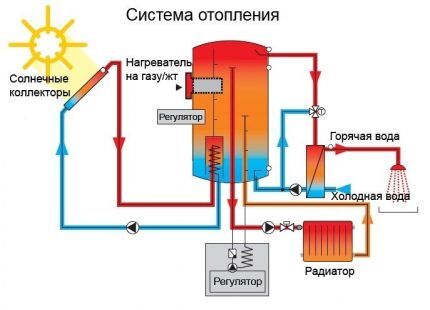
Collectors are a system of tubes connected in series to the output and input lines or laid out in the form of a coil. Process water, air flow, or a mixture of water and some kind of non-freezing liquid circulates through the tubes.
Circulation is stimulated by physical phenomena: evaporation, changes in pressure and density from the transition from one state of aggregation to another, etc.
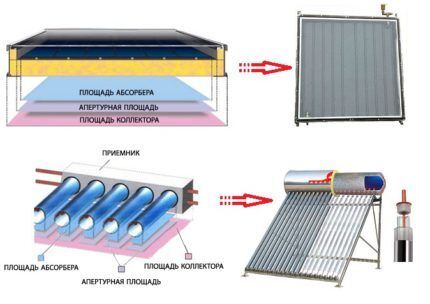
The collection and accumulation of solar energy is carried out by absorbers. This is either a solid metal plate with a blackened outer surface, or a system of individual plates attached to tubes.
For the manufacture of the upper part of the body, the lid, materials with a high ability to transmit light are used. This can be plexiglass, similar polymer materials, tempered types of traditional glass.

It must be said that polymer materials do not tolerate the influence of ultraviolet rays quite well.All types of plastic have a fairly high coefficient of thermal expansion, which often leads to depressurization of the housing. Therefore, the use of such materials for the manufacture of the collector body should be limited.
Water as a coolant can only be used in systems designed to supply additional heat in the autumn/spring period. If you plan to use the solar system all year round, before the first cold snap, change the process water to a mixture of it and antifreeze.

If a solar collector is installed to heat a small building that has no connection with the autonomous heating of the cottage or with centralized networks, a simple single-circuit system with a heating device at the beginning is constructed.
The chain does not include circulation pumps and heating devices. The scheme is extremely simple, but it can only work in sunny summers.
When a collector is included in a double-circuit technical structure, everything is much more complicated, but the range of days suitable for use is significantly increased. The collector processes only one circuit. The predominant load is placed on the main heating unit, running on electricity or any type of fuel.
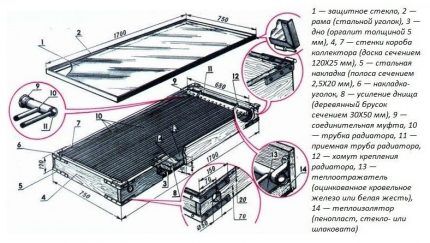
Despite the direct dependence of the performance of solar devices on the number of sunny days, they are in demand, and the demand for solar devices is steadily increasing. They are popular among folk craftsmen who seek to channel all types of natural energy into useful channels.
Classification according to temperature criteria
There are quite a large number of criteria by which certain solar system designs are classified. However, for devices that can be made with your own hands and used for hot water supply and heating, the most rational option would be to separate them by type of coolant.
So, systems can be liquid and air. The first type is more often applicable.
In addition, a classification is often used based on the temperature to which the working components of the collector can be heated:
- Low temperature. Options capable of heating the coolant up to 50ºС. They are used to heat water in irrigation tanks, in bathtubs and showers in the summer and to improve comfortable conditions on cool spring-autumn evenings.
- Medium temperature. Provide a coolant temperature of 80ºС. They can be used to heat rooms. These options are most suitable for furnishing private homes.
- High temperature. The coolant temperature in such installations can reach up to 200-300ºС. They are used on an industrial scale, installed for heating production workshops, commercial buildings, etc.
High-temperature solar systems use a rather complex process of transferring thermal energy. In addition, they occupy an impressive amount of space, which most of our lovers of country life cannot afford.
The manufacturing process is labor-intensive, and implementation requires specialized equipment. It is almost impossible to make such a version of a solar system on your own.
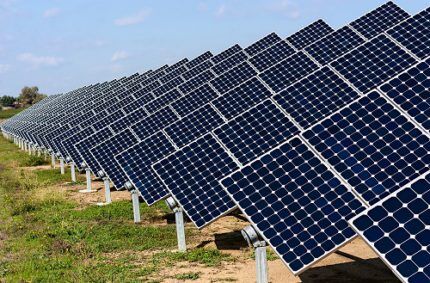
Hand-made manifold
Making a solar device with your own hands is a fascinating process that brings a lot of benefits. Thanks to it, you can rationally use free solar radiation and solve several important economic problems. Let's look at the specifics of creating a flat-plate collector that supplies heated water to the heating system.
DIY materials
The simplest and most affordable material for self-assembly of a solar collector body is a wooden block with a board, plywood, OSB boards or similar options. As an alternative, you can use a steel or aluminum profile with similar sheets. A metal case will cost a little more.
Materials must meet the requirements for structures used outdoors. The service life of a solar collector varies from 20 to 30 years.
This means that materials must have a certain set of performance characteristics that will allow the structure to be used throughout its entire life.
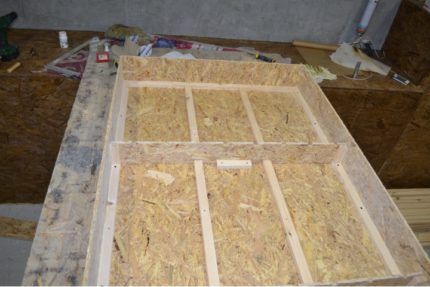
If the body is made of wood, then the durability of the material can be ensured by impregnation with water-polymer emulsions and coating with paints and varnishes.
The basic principle that should be followed when designing and assembling a solar collector is the availability of materials in terms of price and availability. That is, they can either be found on the open market or made independently from available materials.
Nuances of thermal insulation
To prevent loss of thermal energy, insulating material is installed at the bottom of the box. This can be polystyrene foam or mineral wool. Modern industry produces a fairly extensive range of insulating materials.
To insulate the box, you can use foil insulation options. In this way, it is possible to provide both thermal insulation and reflection of sunlight from the foil surface.
If rigid foam or expanded polystyrene board is used as insulation material, grooves can be cut to accommodate the coil or pipe system. Typically, the collector absorber is placed on top of the thermal insulation and firmly fixed to the bottom of the housing in a manner that depends on the material used in the manufacture of the housing.
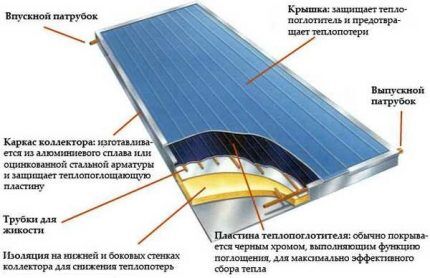
Solar collector heat sink
This is an absorbent element. It is a system of pipes in which the coolant is heated, and parts made most often of sheet copper. The optimal materials for the manufacture of a heat sink are considered to be copper pipes.
Home craftsmen have invented a cheaper option - a spiral heat exchanger made of polypropylene pipes.
An interesting budget solution is a solar system absorber made of a flexible polymer pipe. Suitable fittings are used to connect to the devices at the inlet and outlet. The choice of available materials from which a solar collector heat exchanger can be made is quite wide. This could be the heat exchanger of an old refrigerator, polyethylene water pipes, steel panel radiators, etc.
An important criterion for efficiency is the thermal conductivity of the material from which the heat exchanger is made.
For self-production, copper is the best option. It has a thermal conductivity of 394 W/m². For aluminum, this parameter varies from 202 to 236 W/m².
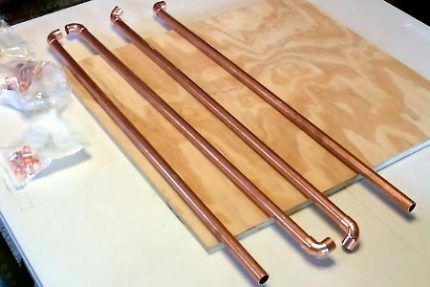
However, the large difference in thermal conductivity parameters between copper and polypropylene pipes does not mean that a heat exchanger with copper pipes will produce hundreds of times larger volumes of hot water.
Under equal conditions, the performance of a heat exchanger made of copper pipes will be 20% more efficient than the performance of metal-plastic options. So heat exchangers made from polymer pipes have a right to life. In addition, such options will be much cheaper.
Regardless of the material of the pipes, all connections, both welded and threaded, must be sealed. The pipes can be placed either parallel to each other or in the form of a coil.
The coil-type circuit reduces the number of connections - this reduces the likelihood of leaks and ensures a more uniform flow of coolant.
The top of the box in which the heat exchanger is located is covered with glass.As an alternative, you can use modern materials, such as an acrylic analogue or monolithic polycarbonate. The translucent material may not be smooth, but grooved or matte.
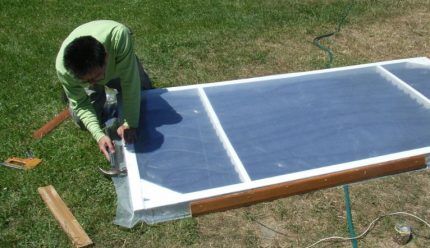
This treatment reduces the reflectivity of the material. In addition, this material must withstand significant mechanical loads.
In industrial samples of such solar systems, special solar glass is used. This glass is characterized by a low iron content, which ensures lower losses of thermal energy.
Storage tank or anterior chamber
Any container with a volume from 20 to 40 liters can be used as a storage tank. A series of slightly smaller tanks connected by pipes in a series chain will do. It is recommended to insulate the storage tank, because Water heated by the sun in a container without insulation will quickly lose thermal energy.
In fact, the coolant in the solar heating system must circulate without accumulation, because The thermal energy received from it must be consumed during the period of receipt. The storage tank rather serves as a distributor of heated water and a front chamber that maintains pressure stability in the system.
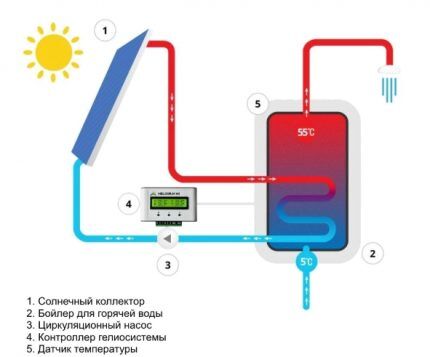
Stages of solar system assembly
After manufacturing the collector and preparing all the constituent structural elements of the system, you can begin direct installation.
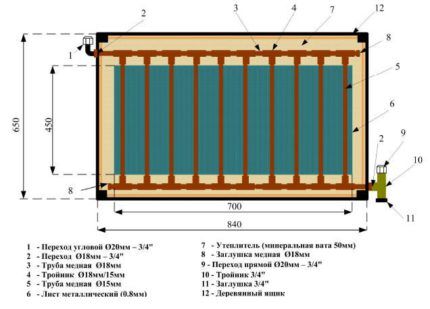
The work begins with the installation of a forward camera, which, as a rule, is placed at the highest possible point: in the attic, free-standing tower, overpass, etc.
During installation, it should be taken into account that after filling the system with liquid coolant, this part of the structure will have an impressive weight. Therefore, you should make sure that the ceiling is reliable or strengthen it.
After installing the container, begin installing the collector. This structural element of the system is located on the south side. The angle of inclination relative to the horizon should be from 35 to 45 degrees.
After installing all the elements, they are tied with pipes, connecting them into a single hydraulic system. The tightness of the hydraulic system is an important criterion on which the efficient operation of the solar collector depends.

To connect structural elements into a single hydraulic system, pipes with a diameter of an inch and a half inch are used. The smaller diameter is used to construct the pressure part of the system.
The pressure part of the system refers to the input of water into the front chamber and the output of the heated coolant into the heating and hot water supply system. The rest is mounted using pipes of larger diameter.
To prevent loss of thermal energy, pipes should be carefully insulated.For this purpose, you can use polystyrene foam, basalt wool, or foil versions of modern insulating materials. The storage tank and front chamber are also subject to the insulation procedure.
The simplest and most affordable option for thermal insulation of a storage tank is to build a box of plywood or boards around it. The space between the box and the container should be filled with insulating material. It can be slag wool, a mixture of straw and clay, dry sawdust, etc.
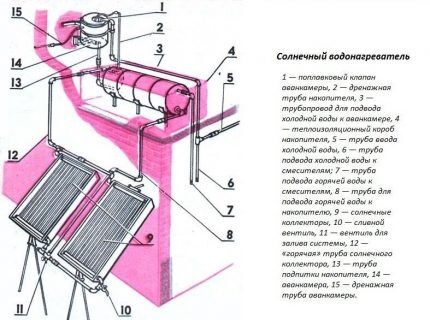
Test before commissioning
After installing all the elements of the system and insulating part of the structures, you can begin to fill the system with liquid coolant. The initial filling of the system should be done through the pipe located at the bottom of the manifold.
That is, filling is carried out from bottom to top. Thanks to such actions, the possible formation of air jams can be avoided.
Water or other liquid coolant enters the front chamber. The process of filling the system ends when water begins to flow from the drainage pipe of the anterior chamber.
Using a float valve, you can adjust the optimal liquid level in the anterior chamber. After filling the system with coolant, it begins to heat up in the collector.
The temperature rise process occurs even in cloudy weather. The heated coolant begins to rise to the upper part of the storage tank. The process of natural circulation occurs until the temperature of the coolant that enters the radiator is equal to the temperature of the coolant leaving the collector.
When water flows into the hydraulic system, the float valve located in the front chamber will be activated. This way a constant level will be maintained. In this case, the cold water entering the system will be located in the lower part of the storage tank. The process of mixing cold and hot water practically does not occur.
In the hydraulic system, it is necessary to provide for the installation of shut-off valves that will prevent the reverse circulation of coolant from the collector to the storage tank. This occurs when the ambient temperature drops lower than the coolant temperature.
Such shut-off valves are usually used at night and in the evening.
Hot water supply to points of consumption is carried out using standard mixers. It is better not to use conventional single taps. In sunny weather, the water temperature can reach up to 80°C - it is inconvenient to use such water directly. Thus, mixers will significantly save hot water.
The performance of such a solar water heater can be increased by adding additional collector sections. The design allows you to mount from two to an unlimited number of pieces.
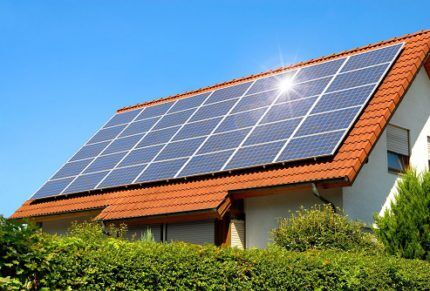
This solar collector for heating and hot water supply is based on the principle of the greenhouse effect and the so-called thermosiphon effect. The greenhouse effect is used in the design of the heating element.
The sun's rays pass unhindered through the transparent material of the upper part of the collector and are converted into thermal energy.
Thermal energy ends up in a confined space due to the tightness of the collector section box. The thermosiphon effect is used in a hydraulic system when the heated coolant rises upward, displacing the cold coolant and forcing it to move into the heating zone.
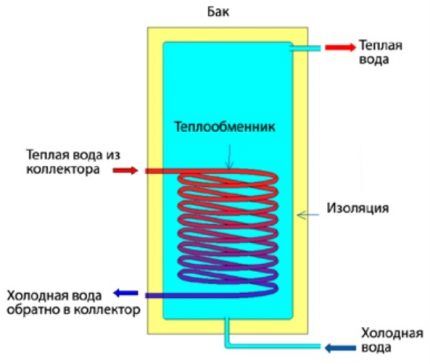
Solar collector performance
The main criterion that affects the performance of solar systems is the intensity of solar radiation. The amount of potentially useful solar radiation falling on a certain territory is called insolation.
The amount of insolation in different parts of the globe varies quite widely. There are special tables to determine the average indicators of this value. They display the average solar insolation for a particular region.
In addition to the amount of insolation, the performance of the system is affected by the area and material of the heat exchanger. Another factor affecting system performance is the volume of the storage tank. The optimal tank capacity is calculated based on the area of the collector adsorbers.
In the case of a flat-plate collector, this is the total area of the pipes that are in the collector box. This value, on average, is equal to 75 liters of tank volume per m² of collector tube area. The storage tank is a kind of heat accumulator.
Prices for factory devices
The lion's share of the financial costs for the construction of such a system falls on the manufacture of collectors. This is not surprising; even in industrial models of solar systems, about 60% of the cost comes from this structural element. Financial costs will depend on the choice of a particular material.
It should be noted that such a system is not able to heat the room; it will only help save on costs by helping to heat the water in the heating system. Considering the fairly large energy costs that are spent on heating water, a solar collector integrated into the heating system significantly reduces such costs.
Quite simple and affordable materials are used for its manufacture. In addition, this design is completely energy independent and does not require technical maintenance. Caring for the system comes down to periodic inspection and cleaning of the collector glass from dirt.
Additional information on organizing solar heating in the house is presented in this article.
Conclusions and useful video on the topic
Manufacturing process of a basic solar collector:
How to assemble and commission a solar system:
Naturally, a self-made solar collector will not be able to compete with industrial models. Using available materials, it is quite difficult to achieve the high efficiency that industrial designs have. But the financial costs will be much lower compared to purchasing ready-made installations.
Nevertheless, homemade solar heating system will significantly increase the level of comfort and reduce the cost of energy generated by traditional sources.
Do you have experience in constructing a solar collector? Or do you still have questions about the material presented? Please share information with our readers. You can leave comments in the form below.
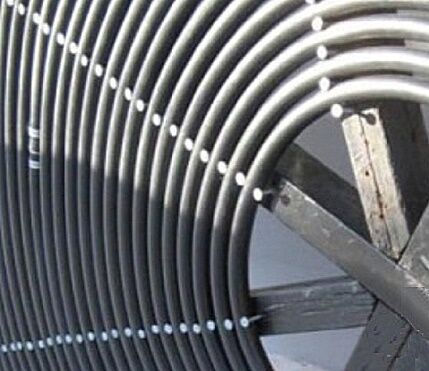

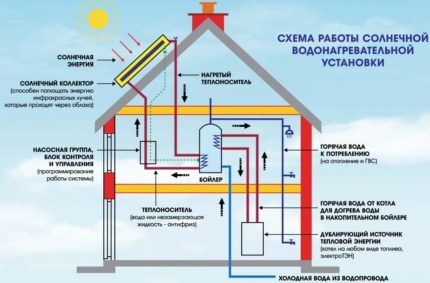




This is all good, but in our country what does this look like legally, I wonder? Suppose I built all this, did it, everything works, and then the neighbor, to whom I once did not give a hundred rubles, sees this whole system and begins - some regulatory authorities, others, if not the police at all. It was not enough to get a fine or even worse. So it would be a good idea to know the legal side of the issue first.
Leonid, what can you be convicted of? For free consumption of solar heat?
If only there was a person, there would be something for it.
Hello!
You have raised a very interesting and important question. So far in Russia there is not a single law that would clearly establish the rights and responsibilities of owners of solar panels. Legal entities using solar energy refer to Federal Law No. 7 of January 10, 2002 on the environmental safety of production enterprises and the “State program to support scientific research and environmental education of citizens.” There is not a single word in the Federal Law about individuals as owners of equipment.
Legal practice shows that private owners of solar panels are faced with the following problem: the battery is installed on the facade or roof of a residential building, which raises questions from the territorial Housing Inspectorate.In this case, government officials are guided by the fact that the battery changes the appearance of the building, and this is not always possible. Therefore, if you have installed or are planning to install a solar battery in a high-rise building, I recommend that you obtain permission from the architectural department of the territorial authority. As a rule, the issue is resolved positively and quickly.
Please also note that you can only use the energy obtained from solar panels to satisfy your household and business needs. If you are going to sell excess electricity, for example to a neighbor, then you need to register as a participant in the retail electricity market and enter into an agreement with the buyer. This norm is prescribed in clause 64 of Federal Law No. 7.
One more nuance: if your battery is connected to the power supply system, then the connection must be “after the meter”, otherwise you may be accused of stealing energy resources.
Hello. There are no legally documented prohibitions on the installation and use of solar collectors and other natural resources - snow, air, wind, rain.
And you give a hundred rubles to your neighbor, and that’s it, there won’t be any problems.
Do not worry. Tomorrow the neighbor will come again. You're giving out 100 rubles, right?
Saving energy is a must. However, both solar collectors and solar panels have a number of limitations: they are effective only in regions with a sufficient number of sunny days. Moreover, we should not forget about the need to think through and arrange means of protecting these batteries from hail. Among other things, you also need to properly organize and carry out their regular cleaning.
Evgeny, but we are not necessarily talking about completely replacing all heating with solar collectors. At the dacha, in the village in the summer (especially where there are problems with power supply), this is a completely working model. Especially for heating water. If the storage tank is well insulated, then in the morning there will be warm water for washing or showering. And - for free!
The conversation about the legal side of the issue reminded me of a funny story about a woman who privatized the Sun and now intends to charge for its use :)) We joked that we wanted to sue her for damage to health from overheating this summer and for the drought :)
The state will not tolerate people consuming free energy, including solar energy.
You may laugh, but if you fully provide your home with solar energy, there will be organs that will prevent this.
About 25 years ago I was surprised that in Europe they use water through a meter, but now you find it funny?
What does the state have to do with it anyway? For almost 30 years, all utility and administrative services have been operating independently and are not owned by the state. It seems like “it’s time for all the partisans to come out of the forest,” the system has changed a long time ago.
Regional energy companies are responsible for energy supply. Calculations are made through Energosbyt. These are joint stock companies that pay taxes to the state, but do not obey. By the way, you also pay taxes to the state, but it does not decide for you where and how you will work.
“25 years ago I was surprised that...” It seems to me that even at that time there were utility bills, no one canceled them in any case.And you don’t need to pay anyone for the solar energy generated by your personal power plant. Well, unless you can sell it. Only in this case can you be required to pay TAXES on your income. Nothing else.